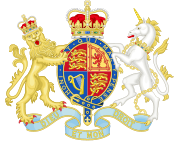- Court of St. James's
-
United Kingdom 
This article is part of the series:
Politics and government of
the United KingdomGovernment- Sovereign
- Queen Elizabeth II
- The Crown
- Royal Prerogative
- Privy Council
- Cabinet
- Her Majesty's Civil Service
Foreign policy
The Court of St James's is the royal court of the United Kingdom.[1] It previously had the same function in the Kingdom of England (before 1707) and in the Kingdom of Great Britain (1707–1800).
Overview
The Court of St. James's is named after St. James's Palace, which is the senior Palace of the Sovereign, currently Queen Elizabeth II.[2] It remains the official residence of the British Monarchy,[1] despite Queen Victoria's moving to Buckingham Palace after her accession in 1837.[1][3]
Although St James's Palace is the official residence of the Sovereign, the Court moves with the Queen. As Buckingham Palace is the official London residence,[3] the court and consequently meetings of the Privy Council occur there, as the Queen does not live at St James's. During her extended stays at Windsor Castle (typically during Easter), Sandringham during Christmas, and at Holyrood Palace or Balmoral Castle in Scotland in the summer, the Court will be at Windsor, Sandringham, Holyrood or Balmoral. When the Queen travels overseas in her role as Queen of the United Kingdom, the court also travels with her.
All Ambassadors and High Commissioners to the United Kingdom are accredited to and received at the Court of St. James's[1] and, as it would not be feasible to do this to a moving Court, a static name was needed. The official residence was therefore chosen because the Marshal of the Diplomatic Corps (before 1920, Master of the Ceremonies), who acts as the link between the Queen and the foreign diplomatic missions, is permanently based there.[2]
In 2009 there were 172 foreign missions accredited to the Court of St James's in London.[4] This total was made up of 46 high commissions (missions from other Commonwealth countries) and 128 embassies (missions from foreign, meaning non-Commonwealth, countries).
See also
References
- ^ a b c d "History of St. James's Palace". The Official Website of the British Monarchy. August 2008. http://www.royal.gov.uk/TheRoyalResidences/StJamessPalace/History.aspx.
- ^ a b "St. James's Palace". The Official Website of the British Monarchy. August 2008. http://www.royal.gov.uk/TheRoyalResidences/StJamessPalace/Today.aspx.
- ^ a b "Buckingham Palace". The Official Website of the British Monarchy. August 2008. http://www.royal.gov.uk/TheRoyalResidences/BuckinghamPalace/BuckinghamPalace.aspx.
- ^ "Ambassadors' credentials". The Official Website of the British Monarchy. August 2009. http://www.royal.gov.uk/RoyalEventsandCeremonies/Audiences/Ambassadorscredentials.aspx.

This article related to British royalty is a stub. You can help Wikipedia by expanding it. - Sovereign
